The ADATA GAMMIX S50 Lite 2TB SSD Review: Mainstream PCIe Gen4
by Billy Tallis on April 30, 2021 8:00 AM ESTMixed IO Performance
For details on our mixed IO tests, please see the overview of our 2021 Consumer SSD Benchmark Suite.
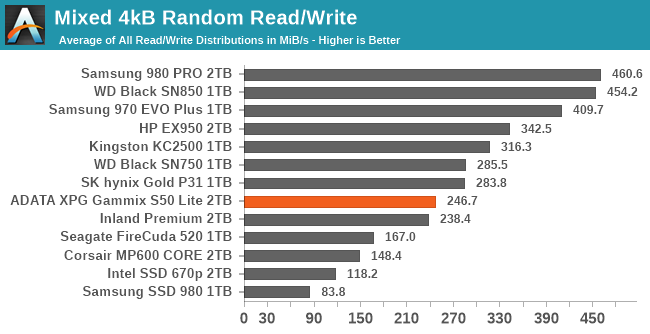 |
|||||||||
| Mixed Random IO | Throughput | Power | Efficiency | ||||||
| Mixed Sequential IO | Throughput | Power | Efficiency | ||||||
The ADATA XPG Gammix S50 Lite has mediocre overall performance on the mixed random IO test and comes in last place among this batch of drives for the mixed sequential IO test. These results aren't too surprising at this point; the mixed IO tests are both conducted on a mostly-full drive without restricting the test to a narrow slice of the drive, and we've already seen that these conditions bring out the worst in the S50 Lite.
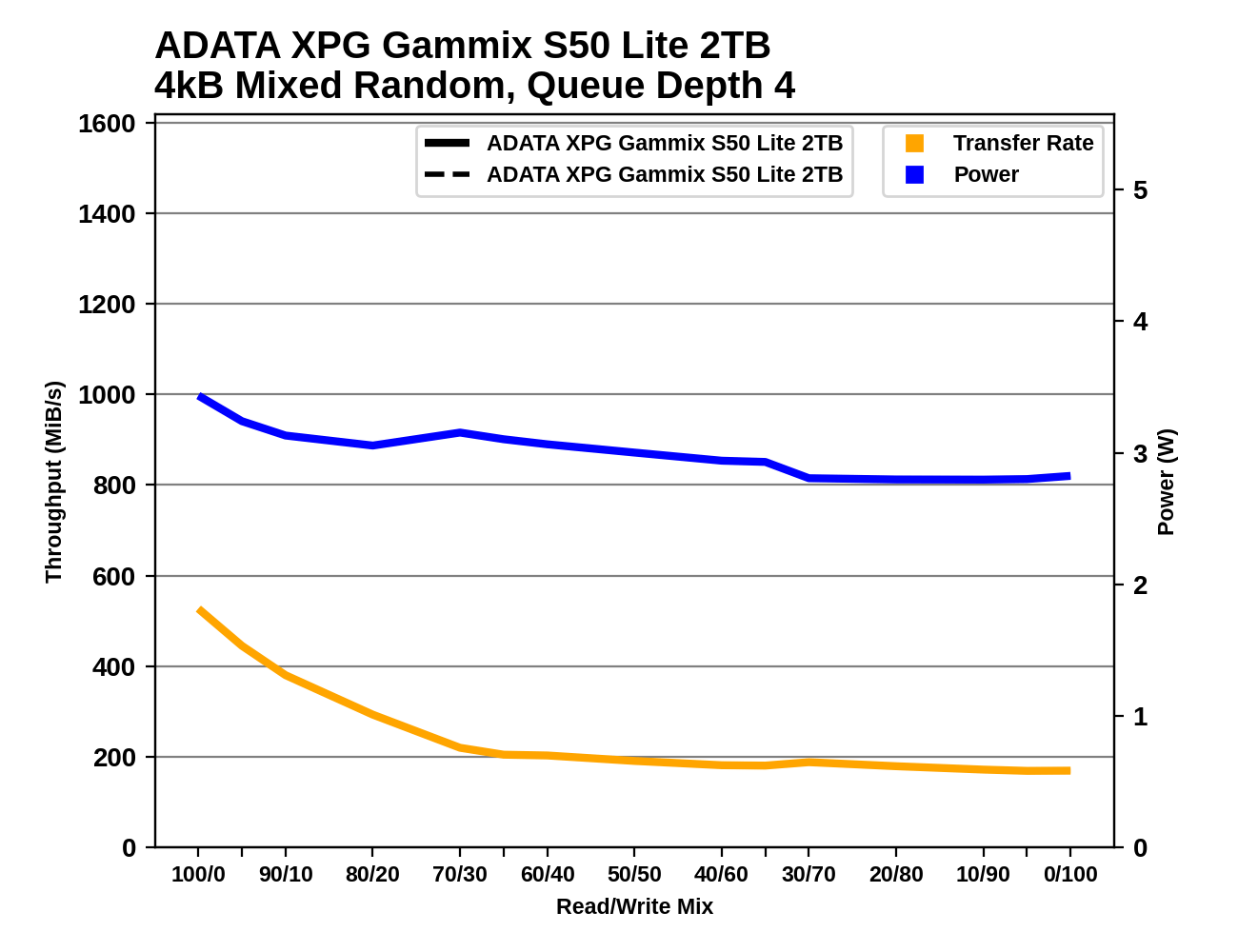 |
|||||||||
| Mixed Random IO | |||||||||
| Mixed Sequential IO | |||||||||
On the mixed random IO test, the S50 Lite is at least fairly consistent; once the workload has more than about 30% writes there isn't much change in the performance. By contrast, the mixed sequential IO test results are a mess, with performance bouncing around with no clear pattern. SLC cache overflow is probably the primary factor here, but it ends up being less consistent than the results from the sustained sequential write test. The fact that we're testing four independent streams of sequential IO is probably also a very poor match for the kind of IO patterns this drive is tuned for.
Power Management Features
Real-world client storage workloads leave SSDs idle most of the time, so the active power measurements presented earlier in this review only account for a small part of what determines a drive's suitability for battery-powered use. Especially under light use, the power efficiency of a SSD is determined mostly be how well it can save power when idle.
For many NVMe SSDs, the closely related matter of thermal management can also be important. M.2 SSDs can concentrate a lot of power in a very small space. They may also be used in locations with high ambient temperatures and poor cooling, such as tucked under a GPU on a desktop motherboard, or in a poorly-ventilated notebook.
| ADATA XPG Gammix S50 Lite NVMe Power and Thermal Management Features |
|||
| Controller | Silicon Motion SM2267 | ||
| Firmware | 82A7T92C | ||
| NVMe Version |
Feature | Status | |
| 1.0 | Number of operational (active) power states | 3 | |
| 1.1 | Number of non-operational (idle) power states | 2 | |
| Autonomous Power State Transition (APST) | Supported | ||
| 1.2 | Warning Temperature | 75 °C | |
| Critical Temperature | 80 °C | ||
| 1.3 | Host Controlled Thermal Management | Supported | |
| Non-Operational Power State Permissive Mode | Not Supported | ||
The S50 Lite supports the most common NVMe power management features, including low-power idle states that are supposed to have quick transition latencies. The maximum power of 9W in the full-power state is a fairly conservative figure; if the drive ever actually draws that much, it's only for very short intervals.
| ADATA XPG Gammix S50 Lite NVMe Power States |
|||||
| Controller | Silicon Motion SM2267 | ||||
| Firmware | 82A7T92C | ||||
| Power State |
Maximum Power |
Active/Idle | Entry Latency |
Exit Latency |
|
| PS 0 | 9.0 W | Active | - | - | |
| PS 1 | 4.6 W | Active | - | - | |
| PS 2 | 3.8 W | Active | - | - | |
| PS 3 | 45 mW | Idle | 2 ms | 2 ms | |
| PS 4 | 4 mW | Idle | 15 ms | 15 ms | |
Note that the above tables reflect only the information provided by the drive to the OS. The power and latency numbers are often very conservative estimates, but they are what the OS uses to determine which idle states to use and how long to wait before dropping to a deeper idle state.
Idle Power Measurement
SATA SSDs are tested with SATA link power management disabled to measure their active idle power draw, and with it enabled for the deeper idle power consumption score and the idle wake-up latency test. Our testbed, like any ordinary desktop system, cannot trigger the deepest DevSleep idle state.
Idle power management for NVMe SSDs is far more complicated than for SATA SSDs. NVMe SSDs can support several different idle power states, and through the Autonomous Power State Transition (APST) feature the operating system can set a drive's policy for when to drop down to a lower power state. There is typically a tradeoff in that lower-power states take longer to enter and wake up from, so the choice about what power states to use may differ for desktop and notebooks, and depending on which NVMe driver is in use. Additionally, there are multiple degrees of PCIe link power savings possible through Active State Power Management (APSM).
We report three idle power measurements. Active idle is representative of a typical desktop, where none of the advanced PCIe link or NVMe power saving features are enabled and the drive is immediately ready to process new commands. Our Desktop Idle number represents what can usually be expected from a desktop system that is configured to enable SATA link power management, PCIe ASPM and NVMe APST, but where the lowest PCIe L1.2 link power states are not available. The Laptop Idle number represents the maximum power savings possible with all the NVMe and PCIe power management features in use—usually the default for a battery-powered system but rarely achievable on a desktop even after changing BIOS and OS settings. Since we don't have a way to enable SATA DevSleep on any of our testbeds, SATA drives are omitted from the Laptop Idle charts.
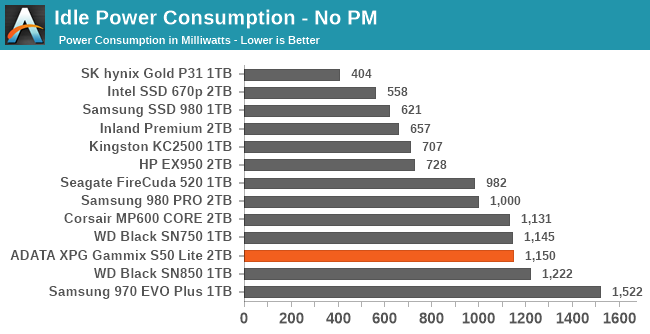
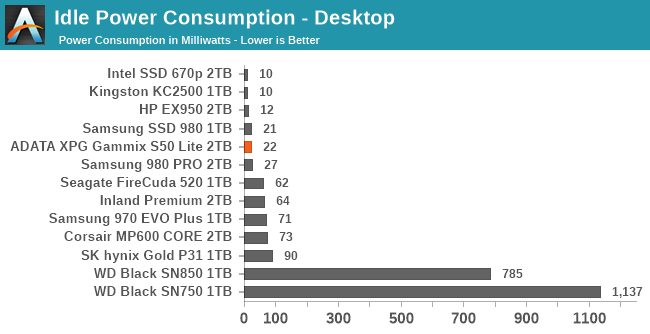
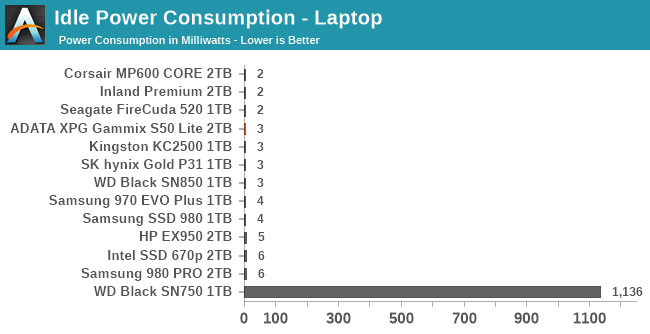
The S50 Lite is one of the more power-hungry drives when idle power management is disabled, drawing over 1W. But the low-power idle states are working well, unlike what we saw with the Intel SSD 670p that uses a close relative of this SM2267 controller. (We're still working with Silicon Motion to figure out that bug.) It also appears that Silicon Motion has moderately improved the real-world wake-up latencies, which are surprisingly high for the SM2262EN drives. The competition shows that there's still room for Silicon Motion to provide an order of magnitude improvement here, and we'd like to see the SMI controllers start living up to the transition times advertised by their firmware.
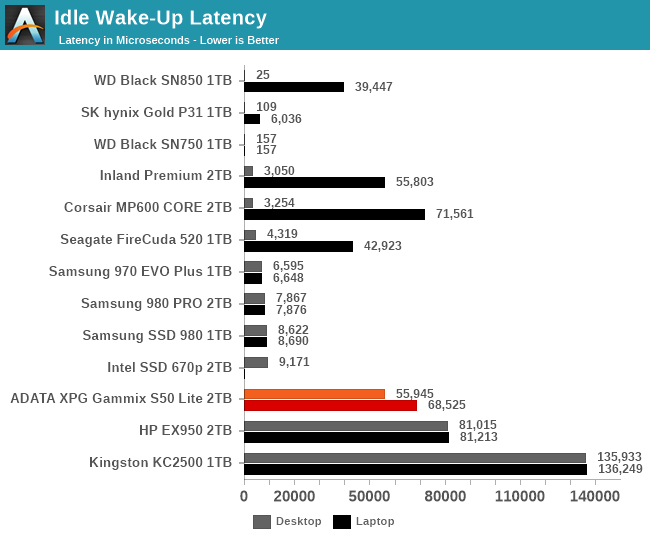










93 Comments
View All Comments
yannigr2 - Friday, April 30, 2021 - link
Years are passing by and the cost per GB is moving up instead of down.deil - Friday, April 30, 2021 - link
but speeds go up a lot. if you compare those to 60GB ssd's of 2005'ish those are 100x fasterStrangerGuy - Sunday, May 2, 2021 - link
Obviously he implies recent price trends in a market where some older products are clearly better then new ones not only in performance/$ but also in absolute performance.But sure please keep up your disingenuous trollish comparisons. Maybe you would also want to elaborate how current GPUs aren't overpriced because they are a million times faster than the 1998 TNT?
TheinsanegamerN - Thursday, May 6, 2021 - link
Take a chill pill dude. You still get way more bang for your buck on sSDs now then you did 3-4 years ago. 4-8TB m.2 drives wern't even an option back then, and PCIe gen 4 is expensive to implement compared to gen 3.Also current GPUs are no more overpriced then the 8800ultra was, which adjusted for inflation was $1100, with NO mining excuses. Didnt even have 1GB of RAM FFS.
Linustechtips12#6900xt - Friday, April 30, 2021 - link
well I think part of that is due to the chip shortage currently but i do agree, things like the intel 660p ssd are a great example of nand prices going down and for the btter a 1tb 90$ ssd, AMAZING as far as im concerned and most notebooks use ssds rather than hard drives, prices havent really gone up much for that super amazing benefit.Oxford Guy - Friday, April 30, 2021 - link
Part of that is the fact that QLC actively works against consumer value, by reducing the economy of scale cost-reduction benefit for TLC.People are literally giving themselves an arrow to the knee when they buy QLC.
Billy Tallis - Friday, April 30, 2021 - link
You keep posting this comment on every article about storage, but that doesn't make it true. Your notion of "economy of scale" is pathetically naive and unconnected to the reality of how NAND flash memory is manufactured. Economies of scale in semiconductor manufacturing come primarily from having more and larger fabs. Using two different mask sets with those production lines instead of just one doesn't ruin those economies of scale. If it did, then you should have been complaining about companies manufacturing both 256Gbit and 512Gbit TLC dies at the same time.Oxford Guy - Friday, April 30, 2021 - link
Calling my argument 'pathetically naive' doesn't make your opinions true either.'Economies of scale in semiconductor manufacturing come primarily from having more and larger fabs. Using two different mask sets with those production lines instead of just one doesn't ruin those economies of scale.'
The reality is that every dollar consumers spend on QLC is a dollar less spent on TLC. That reduces the economy of scale for TLC by reducing TLC production.
Billy Tallis - Saturday, May 1, 2021 - link
"The reality is that every dollar consumers spend on QLC is a dollar less spent on TLC. That reduces the economy of scale for TLC by reducing TLC production."You have no basis for believing that adding some QLC to the mix of a NAND fab's output meaningfully affects the marginal cost of TLC production. I've never seen you hypothesize any mechanism for how that would actually work. You just keep asserting a general economic principal as if it's a fundamental law.
Oxford Guy - Tuesday, May 4, 2021 - link
You are trying to make this seem complex when it's extremely simple.As we have already seen with SLC and MLC, when a cheaper-to-produce technology comes along, production shifts to producing that technology -- reducing availability of the previous products. (That was a serious drawback for consumers before 3D manufacturing made TLC a much better solution than it was.) Scarcity + demand = higher prices. Reducing production increases scarcity. Eventually, it also generally reduces demand which, in turn, reduces production further.
We have already seen this with MLC. It's rather incredible to see anyone claim there is no evidence of exactly the process I've described. It's also extremely simple, and factual, that every dollar spent on QLC is a dollar not spent on TLC -- nor MLC.